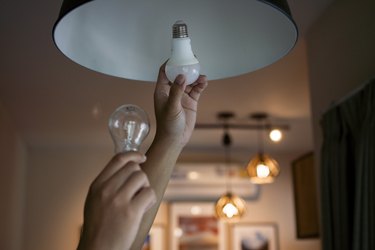Lighting is one thing that can either make or break the look of your home. You could have the most impeccably designed house on the block, but simple lighting mistakes, like choosing the wrong bulbs or mixing and matching contrasting fixtures, can make it feel all wrong. There are simple hacks that designers use all the time that you can apply to your own home lighting situation to make every room feel warm and inviting.
Scale, placement and even the temperature of the lightbulbs all make a huge difference in how your home looks and feels. This doesn't only apply to the interior of your home, though. The exterior spaces, like the backyard, front porch and even your walkway area, deserve good lighting too.
Video of the Day
Video of the Day
Whether your home is one that sees a ton of entertaining or you prefer to keep things cozy and quiet, the lighting can actually play a pivotal role in the function of your place. It shouldn't be just an afterthought. Elements like table lamps, accent lighting and even the placement of the fixtures can become cornerstones in the design.
Learn about 10 simple hacks and lighting ideas you can do today that will give your home a major upgrade.

1. Create a Focal Point
Choose a spot in each room where you want the focal point to be located. This will be one of the first things on which your eyes will land when you walk into the room. Add a dramatic and visually interesting light fixture (or two) to this area. Since this light fixture will be the largest in the room, the rest of the space should be designed around it.
Choose the focal point fixture first and then choose the rest of the elements in the room to ensure things are cohesive. This is a great strategy for homes with large, open floor plans, as it will help differentiate the living room, dining room and kitchen spaces. Just be sure to keep all the other lighting in the space simple and streamlined so it doesn't compete with your focal point light fixture.

2. Put Lights on a Dimmer
Instantly create the perfect mood lighting with the click of a button. Putting your lights on a dimmer switch is an easy way to make any lighting situation feel chic and sophisticated. Best done in the room where you entertain the most, like the living room or den, a dimmable light source will ensure you have the right lighting for every occasion.
This is a pretty easy project to do yourself, but if you don't feel up to the challenge of messing with wires, be sure to call a licensed electrician to help. Whichever route you go, it should be a fairly inexpensive upgrade that will pay for itself for years to come. No one can resist some good mood lighting.
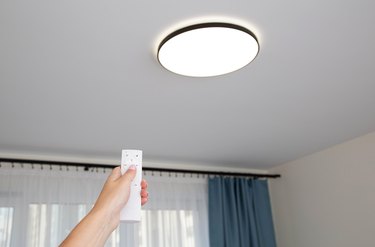
3. Use a Table Lamp for Ambient Lighting
If adding a dimmer switch just isn't in the cards right now, you can still create killer ambient lighting with the help of some strategically placed table lamps. Place one lamp behind the seating area to cast a cozy, intimate glow in your living area that is perfect for get-togethers and casual game nights.
This same effect can also be achieved with a floor lamp placed in the corner of the room. This will add light to the room without blinding your guests. Just pay attention to the lampshade you choose. A lighter-colored lampshade will allow more light to pass through it versus one with a dark shade. Experiment with different colors and textures of lampshades so you can find the one that best fits the room.
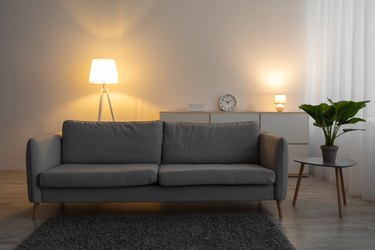
4. Add String Lights to Your Patio
A simple strand of lights can do wonders for the overall feel of your outdoor space. The first thing you'll want to do is choose a location for the lights. They can be along a porch, along a fence or even in a tree in your yard. Choose the area where you and your guests naturally gather the most and hang the lights overhead.
Hang the strands of lights in a delicate, swooping pattern to create a relaxed glow that will have you making any excuse to hang out outside. If the lights are hanging too low for your liking, you can add long pieces of wire to help stabilize the weight of the cord between the bulbs. Small nails will be strong enough to hold the lights, making this an easy DIY. Choose lights with warm yellow bulbs instead of bright white ones to keep the environment cozy and inviting. You can even take things one step further and add a timer to the lights so the mood will always be set no matter what. All you have to do is enjoy it.
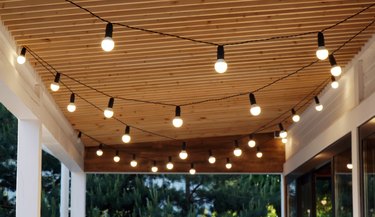
5. Use Outdoor Spotlights
Make your landscaping really pop with the help of a couple spotlights. Start by adding a few near your largest plants, whether they are trees, bushes or shrubs. Place the lights close to the base of the plants and point them upward. If you have a line of bushes or a large tree, you may need to use two or more spotlights.
If your yard gets plenty of direct sunlight, consider solar-powered spotlights so you do not have to mess with cords of any kind. Either way, the lights will help create dramatic shadows that will take your outdoor lighting to the next level by enhancing the landscaping and making the entire area appear lush and interesting. Who knew a tree could look so good at night?

6. Consider Scale When Selecting Light Fixtures
One way to make your home feel like it was decorated by a top interior designer is by paying attention to scale when selecting light fixtures. In homes with wide-open floor plans, one large, dramatic light fixture is better than a few different smaller sconces and pendant lights. If you have high ceilings and lots of open space, you'll want to consider a larger light fixture that commands attention. This is where you can have fun with that large chandelier you've been eyeing. Selecting a larger piece will help define the space and set the tone for the design style of the space. Save the smaller fixtures for smaller and more intimate areas, like the bedroom and home office.
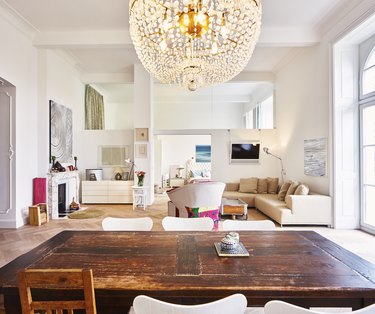
7. Add Strip Lights to Your Television
Beef up your home entertainment situation with a lighting strip. These inexpensive LED lights usually come with a sticky backing that can easily be attached to any surface. They can also be controlled with a remote so you can change the color and pattern of the lights with the push of a button. Surround your television in the accent lighting to make it feel like a cinematic experience every time you and your guests pile on the couch for movie night.

8. Install Sconces Without an Electrician
Are you itching to install wall sconces but don't want to deal with calling an electrician to hard-wire them? You can have the best of both worlds if you buy a few battery-powered lightbulbs. This will allow you to install the sconces like normal without any added fuss. Just screw in the battery-powered lightbulb like you would a regular one and you're all set.
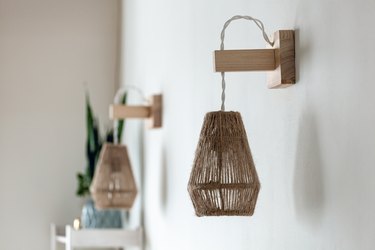
9. Add Pathway Lights
Dress up the exterior of your house with pathway lights that will illuminate the walkway. Opt for a solar-powered version for an easy installation. Not only will your walkway be lit up but the lights will also cast shadows that will make any bushes or shrubs around your front steps look even better. Now, just step back and enjoy the new ambiance happening right outside your front door.
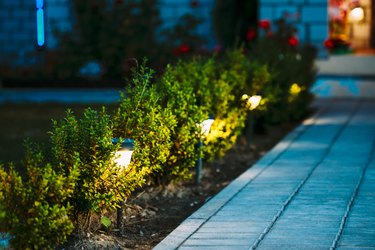
10. Choose the Right Type of Lightbulbs
One of the most important parts of choosing lighting that makes your house feel like a designer showpiece is using the correct lightbulb for each area of your home. It can be overwhelming with terms like "daylight," "bright light" and "natural light" mixed with words like "soft" and "warm" all over the packages.
As a general rule of thumb, you'll want to choose soft lightbulbs that give off a more yellow tone for intimate areas of your home, like the bedroom and living room. Save bright lightbulbs for areas where you need to see clearly, like the bathroom and kitchen. Daylight lightbulbs are right in between and work well in places where a lot of reading takes place since the light will be bright but still easy on the eyes.
